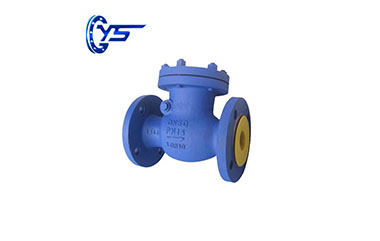The check valve is also called a one-way valve or check valve, its function is to prevent the medium in the pipeline from flowing back. The bottom valve of the pump to close the water is also a check valve. The valve that opens or closes by the flow and force of the medium to prevent the medium from flowing back is called a check valve. Check valves belong to the category of automatic valves. Check valves are mainly used in pipelines where the medium flows in one direction, and only allow the medium to flow in one direction to prevent accidents.
According to the structure of the check valve, it can be divided into three types: lift check valve, Swing Check Valve price, and butterfly check valve. Lift check valves can be divided into two types: vertical check valves and horizontal check valves. Swing check valves are divided into three types: single-leaf check valve, double-leaf check valve, and multi-leaf check valve. The butterfly check valve is a straight-through check valve. The above-mentioned check valves can be divided into three types in connection form: threaded check valve, flanged check valve, and welded check valve.

Swing Check Valve
The installation of the check valve should pay attention to the following things:
1. Do not allow the check valve to bear weight in the pipeline. Large check valves should be independently supported so that they are not affected by the pressure generated by the piping system.
2. When installing, pay attention to the direction of medium flow should be consistent with the direction of the arrow voted by the valve body.
3. The lifting of the vertical flap check valve should be installed on the vertical pipeline.
4. The lifting horizontal flap check valve should be installed on the horizontal pipeline.
Nominal pressure or pressure level of check valve: PN1.0-16.0MPa, ANSI CLASS 150-900, JIS10-20K Nominal diameter or caliber: DN15~900, NPS 1/4 ~36 Connection method: flange, butt welding, Suitable temperature for thread and socket welding: -196℃~540℃ Body material: WCB, ZG1Cr18Ni9Ti, ZG1Cr18Ni12Mo2Ti, CF8 (304), CF3 (304L), CF8M (316), CF3M (316L), Ti. Selecting different materials, the check valve can be applied to water, steam, oil, nitric acid, acetic acid, oxidizing media, urea and other media.
The check valve only allows the medium to flow in one direction and prevents the flow in the opposite direction. Normally, check valves work automatically. Under the action of fluid pressure flowing in one direction, the valve flap opens; when the fluid flows in the opposite direction, the fluid pressure and the weight of the valve flap and the valve flap act on the valve seat to cut off the flow.
Check valves include swing check valves and lift check valves.
The swing check valve has a hinge mechanism and a valve flap like a door that rests freely on the inclined valve seat surface.
In order to ensure that the valve clack can reach the proper position of the valve seat surface every time, the valve clack is arranged on the hinge mechanism so that the valve clack has enough space for rotation and makes the valve clack truly and comprehensively contact the valve seat.
The valve disc can be made of metal, or inlaid with leather, rubber, or synthetic covering, depending on the requirements of the applicable performance.
When the swing check valve is fully opened, the fluid pressure is almost unimpeded, so the pressure drop through the valve will be relatively small.
The disc of the Stainless Steel Lifting Check Valve is seated on the sealing surface of the valve seat on the valve body. Except that the disc can be lifted and lowered freely, the rest of this valve is like a shut-off valve. The fluid pressure lifts the disc from the sealing surface of the valve seat. The backflow of the medium causes the disc to fall back onto the valve seat and cut off the flow.
According to the applicable conditions, the valve disc can be made of an all-metal mechanism, or in the form of a rubber pad or a rubber ring inlaid on the disc frame.
Like a stop valve, the passage of fluid through the lift check valve is also narrow, so the pressure drop through the lift check valve is larger than that of the swing check valve, and the flow rate of the swing check valve is affected by The restrictions are few.
Copyright © Hebei Yaosheng IM & EX Trading Co.,Ltd. All Rights Reserved |Sitemap | Technical Support: 
